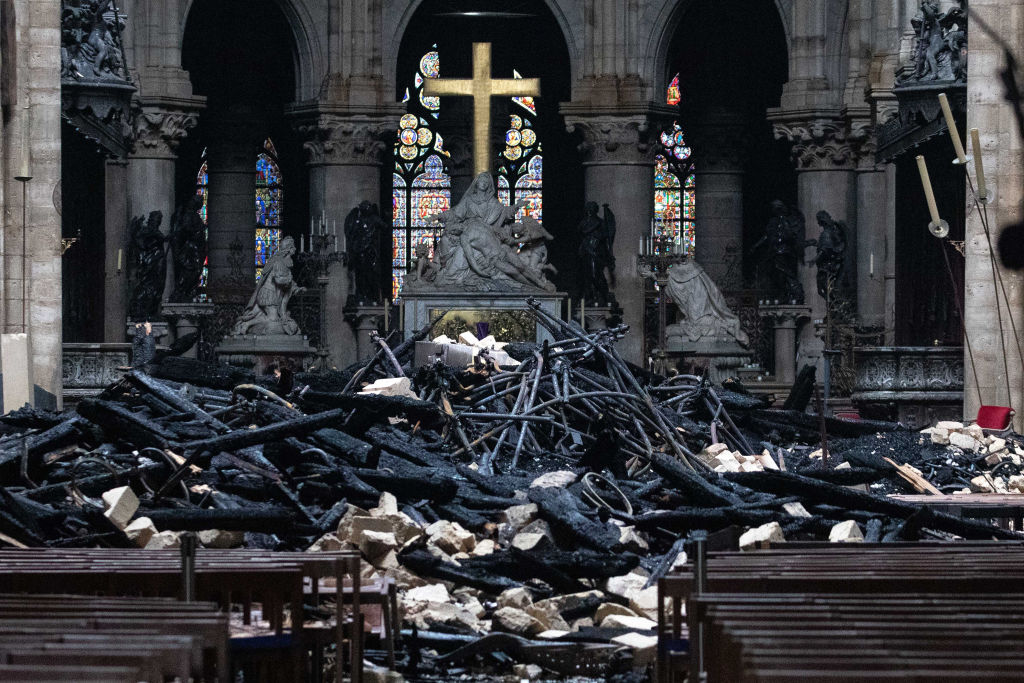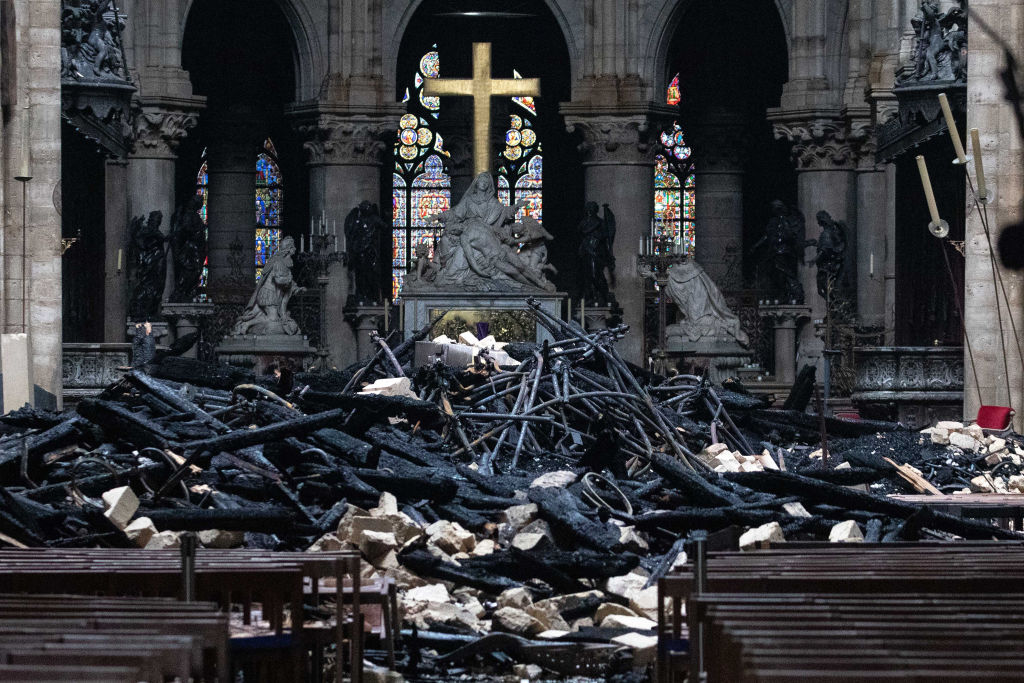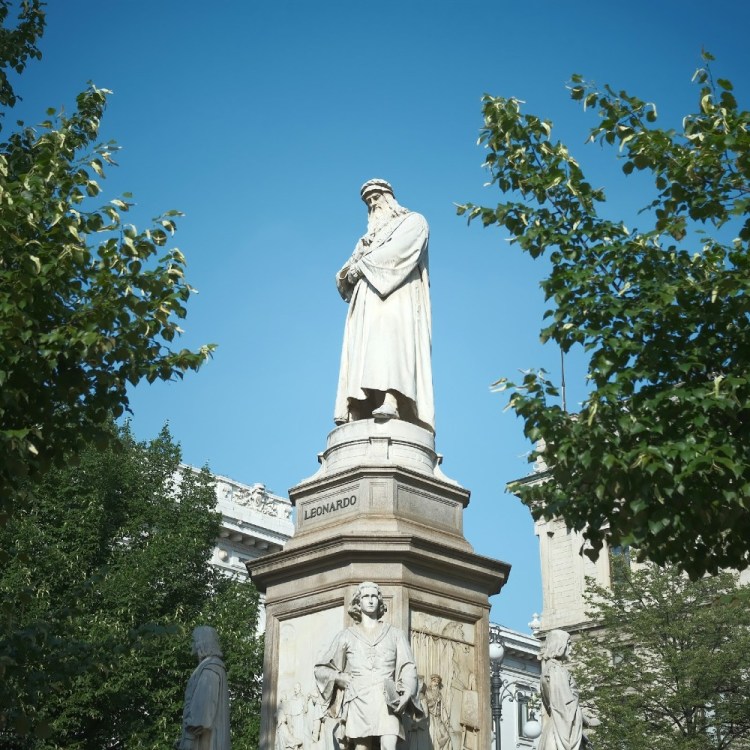A horrific fire tore through Paris’ Notre-Dame Cathedral on Monday, bringing down its 13th-century roof and iconic spire. Though firefighters initially feared the entire church could be lost, the responders heroic efforts spared much more of the UNESCO World Heritage monument than expected.
At the height of the blaze, when it was clear that standard fire-fighting measures would not be enough to save the ceiling from imploding on the rear of Notre Dame, Paris Deputy Mayor Emmanuel Gregoire told French media that first responders reorganized their efforts to focus on saving the priceless art housed in the cathedral. That effort appears to have been largely successful, but the devastation was still profound.
Here’s what we know has been saved and lost, who’s pledged to help rebuild and what comes next for Notre Dame.

What remains intact?
Those fearing the worst for the two enormous, rectangular bell towers of Notre Dame, its magnificent rose windows, flying buttresses and the rest of the building’s general structure can take comfort in knowing that those embodiments of Medieval French architecture were saved. The true extent of the damage cannot be known until a full survey has been conducted, but early photographs from inside the famed cathedral appear promising, Slate reported. An important set of copper statues representing the 12 apostles and four evangelists that once graced the top of the cathedral were removed prior to the start of renovations (which are believed to be linked to the seemingly accidental fire, according to the Associated Press). A number of valuable pieces of art were reportedly saved by firefighters from inside the landmark but it is unclear which, exactly, made it out.
While the cathedral’s main bell, a 15th-century piece called the Emmanuel bell, survived, it has yet to be officially confirmed whether the bells in the two towers were preserved. The Emmanuel bell has chimed in celebration of the end of the Second World War and in honor of those lost in the Sept. 11 terror attacks.
Perhaps most significantly for the Catholic faithful is the news that the braided Crown of Thorns believed to have been worn by Jesus Christ during his cruxifixction has survived, according to NBC News. Its rescue is reportedly being credited in part to the chaplain of the Paris fire brigade, Jean-Marc Fournier, who insisted on being allowed into the burning cathedral with firefighters to pull the relic from the flames.
The awe-inspiring South Rose window, created in 1260, has also seemingly survived, along with two similar windows. The full extent of the damage to each has not yet been assessed, however. The status of the church’s many other stained-glass pieces also remains unknown. It was also reported that Notre-Dame’s famed Great Organ, one of the world’s oldest, did not burn but may have suffered some water damage.

What was lost in the fire?
The spire, one of the more modern features of the grand cathedral that was built in the 19th century during a wave of restoration efforts in the aftermath of Victor Hugo’s success with The Hunchback of Notre Dame ,was consumed by flames on Monday evening. Hugo’s book is one of the greatest celebrations of the cathedral, in which he notes that it has been through ravaging and rebuilding before: “Great edifices, like great mountains, are the work of centuries,” Book Three of Hugo’s work reads. “Art often undergoes a transformation while they are pending, pendent opera interrupta; they proceed quietly in accordance with the transformed art.”
The wooden roof that encased the rear of Notre Dame, known as “the forest” because of the enormous amount of wood used in its construction, was eaten up by flames as well. Part of its structure dates to the 13th century, and was made primarily from trees cut between 1160 and 1170 — some of the oldest materials used in the building.
What has been lost is still largely unknown, however, and will not be made clear until after cleanup efforts are completed. The church’s pews, doorways, the frames of artwork and the delicate paint used on masterpieces from centuries ago were potentially susceptible to the heat and power of the fire that engulfed Notre Dame. The fate of the building’s exterior stones and classic gargoyles is still unknown, too, but experts are hopeful that pieces inside the cathedral, like one statue of Madonna and Child that dates back to the 14th century, survived.
How will Notre Dame be rebuilt?
French President Emmanuel Macron, in an address just before midnight in Paris, vowed that the cathedral will again be a symbol of Parisian culture and history. “I tell you solemnly tonight,” he said. “We will rebuild this cathedral.”
To help, two of France’s richest businessmen have pledged a combined total of €300 million ($339.2 million) to help rebuild the cathedral, the Wall Street Journal reported. Bernard Arnault, chairman and chief executive of LVMH Moët Hennessy Louis Vuitton SE, said his family and the luxury-goods company will donate €200 million to the reconstruction. Another billionaire, Kering SA chairman and chief executive François-Henri Pinault, said his family will donate €100 million to the effort. France’s Capgemini SE said it would give €1 million and energy giant Total SA plans to donate €100 million. French cosmetics company L’Oreal is also pledging to donate €100 million ($113 million) to support the reconstruction effort, and Bouygues construction group CEO Martin Bouygues said he and his brother Olivier would donate €10 million.
Greece’s government has offered France assistance in restoring fire damage to Notre Dame cathedral, the AP reported Tuesday. The nation said it is ready and willing to provide academic experts and skilled technicians from its own restoration projects. Germany has also pledged to lend a hand and is urging the rest of Europe to follow suit.
German President Frank-Walter Steinmeier called for “the citizens of this country and the whole of Europe to support the reconstruction of Notre Dame” and added that the cathedral “is not only a great building, it is a great European landmark, a landmark of European culture and an important document of European history.”
Audrey Azoulay, the Director-General of UNESCO, said Tuesday that experts need to move into Notre Dame to asses the damage, plan for next steps and that “the first 24, 48 hours” are crucial to protecting the stone and wood structure from water damage. She warned that parts of the cathedral remain “extremely fragile,” especially the many tons of scaffolding set up during the restoration work that may have started the blaze itself, the AP reported.
UNESCO has also offered its expertise to help rebuild.
Notre Dame has “a particular place in the world’s collective imagination,” Azoulay said.
This article appeared in an InsideHook newsletter. Sign up for free to get more on travel, wellness, style, drinking, and culture.
























